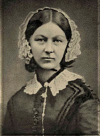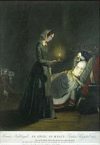SARS-CoV-2 (COVID-19) and the Teaching of Ignaz Semmelweis and Florence Nightingale: a Lesson of Public Health from History, after the "Introduction of Handwashing" (1847)
- PMID: 34909488
- PMCID: PMC8639136
- DOI: 10.15167/2421-4248/jpmh2021.62.3.2161
SARS-CoV-2 (COVID-19) and the Teaching of Ignaz Semmelweis and Florence Nightingale: a Lesson of Public Health from History, after the "Introduction of Handwashing" (1847)
Abstract
Ignác Fülöp Semmelweis (1818-1865) and Florence Nightingale (1820-1910) were two important personalities in the history of medicine and public health. They dealt with the problem of handwashing. Semmelweis is also known as the "father of hand hygiene"; just in 1847 he discovered the etiology and prophylaxis of puerperal sepsis and imposed a new rule mandating handwashing with chlorine for doctors. He also tried to persuade European scientific community of the advantages of handwashing. During the Crimean War, in Scutary (Turkey), Florence Nightingale strengthened handwashing and other hygiene practices in the war hospital where she worked and her handwashing practices reached a reductions in infections. Unfortunately the hygiene practices promoted by Semmelweis and Nightingale were not widely adopted. In general handwashing promotion stood still for over a century. During current pandemic SARS-CoV-2 (COVID-19) one of the most important way to prevent the spread of the virus is still to wash the hands frequently.
Keywords: F. Nightingale; Hand hygiene; Hand washing; History of public health; I. Semmelweis; SARS-CoV-2 (COVID-19).
©2021 Pacini Editore SRL, Pisa, Italy.
Conflict of interest statement
Conflict of interest statement The authors declare no conflict of interest.
Figures





Similar articles
-
Semmelweis and the aetiology of puerperal sepsis 160 years on: an historical review.Epidemiol Infect. 2008 Jan;136(1):1-9. doi: 10.1017/S0950268807008746. Epub 2007 Jun 7. Epidemiol Infect. 2008. PMID: 17553179 Free PMC article.
-
Historical perspectives on health. Semmelweis: a lesson to relearn?J R Soc Promot Health. 1998 Dec;118(6):367-70. doi: 10.1177/146642409811800617. J R Soc Promot Health. 1998. PMID: 10076700
-
A twenty-first century perspective on concepts of modern epidemiology in Ignaz Philipp Semmelweis' work on puerperal sepsis.Eur J Epidemiol. 2022 May;37(5):437-445. doi: 10.1007/s10654-022-00871-8. Epub 2022 Apr 29. Eur J Epidemiol. 2022. PMID: 35486338 Free PMC article. Review.
-
How dramatic were the effects of handwashing on maternal mortality observed by Ignaz Semmelweis?J R Soc Med. 2013 Nov;106(11):459-60. doi: 10.1177/0141076813507843. J R Soc Med. 2013. PMID: 24158917 Free PMC article. No abstract available.
-
Dr. Ignaz Phillip Semmelweis: The Unrecognized Pioneer of Aseptic Practices.Cureus. 2024 Aug 31;16(8):e68350. doi: 10.7759/cureus.68350. eCollection 2024 Aug. Cureus. 2024. PMID: 39355067 Free PMC article. Review.
Cited by
-
The reflective measurement model of adherence to non-pharmaceutical interventions (NPIs) in accordance with normalization process theory (NPT) in coherent and convenient social subgroups: PLS-SEM analysis.Eur J Public Health. 2024 Oct 1;34(5):902-907. doi: 10.1093/eurpub/ckae085. Eur J Public Health. 2024. PMID: 38725266 Free PMC article.
-
Perceived Barriers and Enablers of Nursing Research in the Italian Context: Findings from a Systematic Review.Zdr Varst. 2022 Jun 28;61(3):181-190. doi: 10.2478/sjph-2022-0024. eCollection 2022 Sep. Zdr Varst. 2022. PMID: 35855377 Free PMC article.
-
Florence Nightingale (1820-1910): The Founder of Modern Nursing.Cureus. 2024 Aug 5;16(8):e66192. doi: 10.7759/cureus.66192. eCollection 2024 Aug. Cureus. 2024. PMID: 39233972 Free PMC article. Review.
-
The Folk Concept of Nursing in Australia: A Decolonising Conceptual Analysis.Nurs Philos. 2025 Jan;26(1):e70012. doi: 10.1111/nup.70012. Nurs Philos. 2025. PMID: 39878203 Free PMC article.
-
Increasing Importance of Florence Nightingale's Theory During the 21st-Century Pandemic Period.Florence Nightingale J Nurs. 2023 Oct;31(3):215-216. doi: 10.5152/FNJN.2023.23010. Florence Nightingale J Nurs. 2023. PMID: 37847017 Free PMC article. No abstract available.
References
-
- Borghi L, Lippi D. La penna di Florence Nightingale (Firenze 1820 - Londra 1910). Aforismi e riflessioni. Firenze: A. Pontecorboli; ed. 2020.
-
- McIntyre N. Ignác Fülöp Semmelweis (1818-65). J Med Biogr 2009;17:22. https://doi.org/10.1258/jmb.2008.008008 10.1258/jmb.2008.008008 - DOI - PubMed
-
- Semmelweis Ignaz. (1861). Etiology, concept and prophylaxis of childbed fever. K. Codell Carter (translator and extensive foreword). University of Wisconsin Press 1983, pp. 87-8.
-
- Lancaster HO. Semmelweis: a rereading of Die aetiologie. Part I: Puerperal sepsis before 1845. Die aetiologieJ Med Biogr 1994;2:12-21. https://doi.org/10.1177/096777209400200104 10.1177/096777209400200104 - DOI - PubMed
-
- Raju TN. Ignác Semmelweis and the etiology of fetal and neonatal sepsis. J Perinatol 1999;19:307-10. - PubMed
Publication types
MeSH terms
LinkOut - more resources
Full Text Sources
Medical
Miscellaneous
